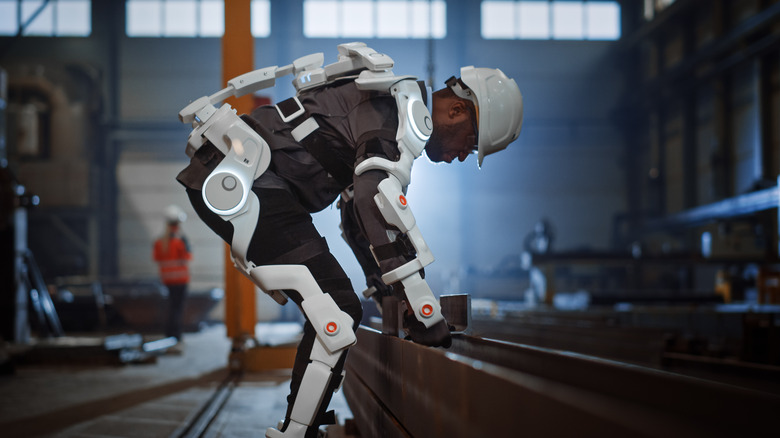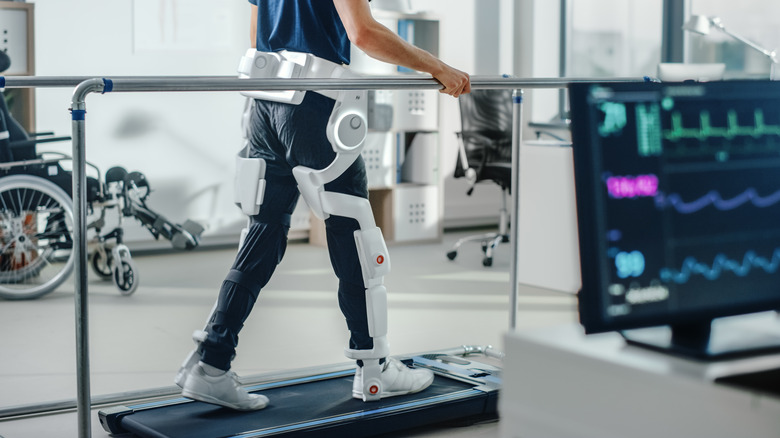Here's Why Military Exoskeletons May Never Become A Reality
The tech-savvy Marvel enthusiasts among us certainly nurtured childhood dreams of one day being Iron Man. There's something more relatable about him than much of the rest of the Avengers crew: a genius-level scientist and engineer the character may be, but he's also not afraid to goof off and speak his mind. He also has a beautifully sarcastic sense of humor and, critically, no superpowers. Essentially, anybody capable of piloting the suit could become the famed Iron Avenger.
Through the course of Iron Man's journey and the comics that inspired it, fans see the suit advance from something salvaged and hammered together to a marvel of nano-tech that forms around Tony Stark's body seemingly autonomously. It's equipped with a phenomenally advanced AI and all the weapons its pilot could possibly want or imagine, and could presumably win any modern war single-handedly.
As such, the creator of a real-life military exoskeleton even remotely comparable could surely name their astronomical price. Sadly, it seems that humanity may never see such an innovation. Here are some of the major roadblocks.
An exoskeleton would have to speed the user up, not slow them down
Historically, soldiers' armor is acclimated to region and technology available. A suit of armor, in modern terms, would be intended more to enhance the wearer's strength, stamina, and agility than to defend against any and all attacks. Very little, after all, can protect a wearer from today's missiles and bombs. As such, enhanced physical capabilities to make soldiers faster and stronger would be the way to go. But it also presents a major problem for an Iron Man suit.
Vikram Mittal, of the Department of Systems Engineering at the U.S. Military Academy, writes that any hypothetical suit would need to be worn in a uniform-esque fashion by a force of soldiers, according to Forbes. Everyone's body, naturally, is different, and so being useful to all potential wearers (indeed, usable at all) is a huge concern. Adaptation to movements is another primary problem, Mittal explains: "Without rapid sensing, the lag between the operator desiring to move and the actual movement results in the operator feeling like they are moving through a pool of Jell-O."
Any exoskeleton, in short, will need to react and move as quickly as the wearer's muscles do, or its use will be entirely impractical.
More strength, more weight
U.S. soldiers carry a lot of heavy equipment. In September 2018, Center for a New American Security reported that the gear worn by a trooper to protect their body and heads weighed around 27 pounds. Such equipment must strike that balance between protecting the user and not hampering their movement too much. This is a conundrum that military exoskeletons have been grappling with since the earliest iterations of the concept.
GE's Hardiman Project began in 1965. This early exoskeleton venture had a lofty goal — to enable the wearer to carry loads of up to 1,500 pounds. Essentially, Hardiman would make its wearer 25 times stronger (or make loads carried feel 25 times lighter, if that makes the concept easier to understand). Some success was reportedly had with the intriguing dual-system, which comprised an outside body and an interior one that was actually attached.
The prototype had a lot of potential in the field of lugging heavy equipment that soldiers otherwise couldn't alone, but that was exactly what it remained: a prototype. The primary drawbacks were that it moved slower than 2 mph, and it was vast and unwieldy. It could carry 1,500 pounds, yes, but that was also its weight. Maneuverability, as such, was not its strong suit. Ultimately, GE notes, "weight, lack of stability and power supply issues" doomed the Hardiman as far as its original intended use went. Some of these issues remain today.
Excellent exoskeletons
Needless to say, the sort of technology that a successful exoskeleton would require has advanced an incredible degree since the time of the clumsy, lumbering Hardiman. For instance, in 2021, BBC News noted Bioservo's Iron Hand, which is worn on the hand and adjusts to the grip of the user. Such technology, in addition to its utility in construction and other industries, would help to tackle a classic issue in robotics: knowing its own strength.
Such support for various body parts has huge applications in medicine, and has been supporting injury recovery in helping people learning to walk again, to bend again.
Science fiction has often broached the concept of robots fighting wars for humans, and as drones become more sophisticated and widespread alongside the field of robotics, the future could head in that direction instead. In a 2020 interview with Sky News, General Sir Nick Carter stated of the British military's prospects for the 2030s, "I suspect we could have an army of 120,000, of which 30,000 might be robots." Though he stated that they won't be directly firing weapons under their own power, such machines could represent another factor that invalidates military exoskeletons: If one goal of such a project was to keep soldiers safer, isn't it better to keep them out of the machine?



